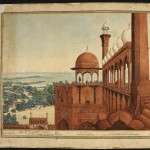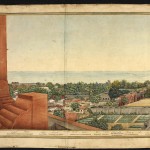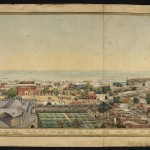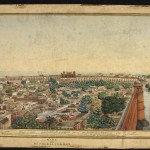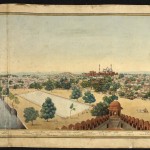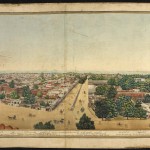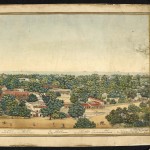Home / The Last Atelier: Ghulam Ali Khan
The Last Atelier: Ghulam Ali Khan
The last great atelier of Mughal painting revolved around the family of one man, Ghulam Ali Khan. The artist described himself in an inscription on one of his most celebrated pictures, as “the hereditary slave of the dynasty, Ghulam Ali Khan the portraitist, resident at Shahjahanabad.” Elsewhere he signs himself simply “His Majesty’s Painter.” Although Ghulam Ali Khan’s family were very proud of their status as hereditary painters to the Mughal throne, the truth was slightly more complex.
The Mughal court no longer had sufficient funds to retain Ghulam Ali Khan exclusively, and to survive the painter had to moonlight as an architectural and portrait painter to several other members of Delhi’s high society made up of European officers, influential chieftains, and other regional rulers. These included the Nawab of Jhajjar, who Ghulam Ali Khan painted astride his pet tiger. The painter also worked for several British patrons, including the Rajput-Scottish mercenary James Skinner and for British Residents at the Mughal court including William Fraser, who became the painter’s principal patron by the 1830’s. As Fraser’s purchasing power gradually eclipsed that of the Emperor, Ghulam Ali Khan and his family worked on the Fraser Album, the supreme masterpiece of the period.
In addition to Ghulam Ali Khan, we know of other members of the family who produced remarkable work ib this period. The oldest, Ghulam Murtaza Khan, was the court painter of the penultimate Mughal Emperor Akbar II. He continued to work in the refined style of the seventeenth-century—his figures display a restrained naturalism reminiscent of the formality of compositions during the reign of Shah Jahan. The painter according to descendants was related to Ghulam Ali Khan, and was perhaps his father. Another painter, Faiz Ali Khan who is the painter of two stunning group portraits on display here, was almost certainly Ghulam Ali’s brother and with his son worked on architectural renderings for the British Resident, Thomas Metcalfe. Finally, Mazhar Ali Khan, a close relation, was primarily an architectural painter who produced the commissions from the last atelier including the great Delhi panorama for Metcalfe on view in this gallery.
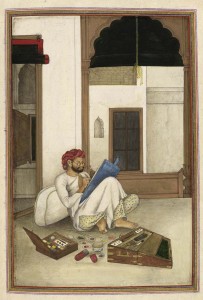
Artist (f.258b) Tashrih al-aqvam, an account of origins and occupations of some of the sects, castes, and tribes of India, written for Colonel James Skinner 1825 Watercolor and body color on paper H. 12 15⁄16 × W. 9 in. (31.3 × 22.9 cm) British Library, Add.27255
Skinner first commissioned a book of images of the noblemen of the region around Delhi, the Tazkirat al-umara, then this album, which is a book of images of ordinary people from bird catchers and opium dealers, to musicians, and sword sharpeners. This page shows a bespectacled painter surrounded by his brushes, his pigments in their oyster shells, and pen boxes painting in the old Mughal manner with an album resting on his raised knee amid the arches and open balcony of a spacious Mughal mansion. It may well be a self-portrait of the Skinner artist, or even Ghulam Ali Khan, the most coveted artist of Delhi.
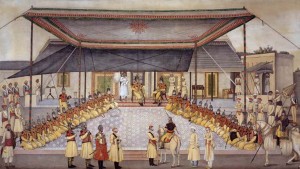
Ghulam Ali Khan (active 1817–55) Colonel James Skinner holding a regimental darbar 1827 Watercolor with gouache on paper H. 30 1⁄2 × W. 52 3⁄4 in. (77.5 × 134 cm) National Army Museum, London, 1956-02-27- 3
The work of Ghulam Ali Khan the painter, resident of the Seat of the Empire Shahjahanabad, it was completed in the Christian year 1827. (Translation of Nastaliq inscription: amal-i ghulam li khan musavvir sakin-i dar al-khilafat shahjahanabad dar sanah 1827 isavi t(ai)yar shud) This record of Skinner’s regiment was one of three monumental commissions executed by the Delhi painter Ghulam Ali Khan for James Skinner. Ghulam Ali Khan prepared individual study portraits of many retainers and cavalrymen over a few years before combining them into this single setting. He has positioned Skinner above eye level, seated on a chair along with his son, James, who was an adjutant (“Ajtan James Skinner Sahib”) in the regiment. The cavalry officers (rissaldars) are dressed in their resplendent yellow winter uniforms, their seated position evoking the formality of a Mughal darbar. The most senior rissaldar, Muhammad Shadull Khan, who had saved Skinner’s son’s life in a previous battle, sits closest to him. According to contemporary observers they were, “reckoned to be the most useful and trusty, as well as the boldest body of men in India.”
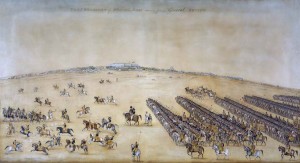
Ghulam Ali Khan (active 1817–55) View of the cantonment at Hansi 1828 Watercolor on paper H. 28 1⁄8 × W. 50 in. (71.5 × 127 cm) National Army Museum, 1956-02-27-2
The work of Ghulam Ali Khan, painter who created this work in the month of August in the Christian year 1828); naqshah i shahr va qila yi hansi va chhaoni-yi sawaran-i rajimant (Picture of the town and fort of Hansi and the cantonment of the cavalry regiment (Translation of Nastaliq inscription: amal-i ghulam ali khan mussavir muharrar-hu mah-i august san isavi 1828). Here, Ghulam Ali Khan captures James Skinner and his bearded friend, William Fraser, returning to their base at Hansi Fort and cantonment with a large regimental contingent of Skinner’s Horse marching in perfect file behind them. Fraser held an honorary post in Skinner’s regiment, and also commissioned many studies of ‘the Yellow Boys,’ the nickname for the men in Skinner’s cavalry who wore bright yellow uniforms. Skinner’s trusted men of mid-level rank (rissaldars) lead long files of cavalrymen, some of whom are seen carrying yellow banners with the motto: “himmat-i mardan, madad-i khuda” (The strength of man, the help of God). To the left, some horsemen (sowars) display their skills of horsemanship and warfare. Some vignettes in the sequence are derived from a set of illustrations intended to accompany a manual of cavalry manoeuvres and weaponry that Skinner had dictated to his scribe in 1823.
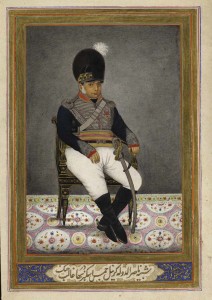
Colonel James Skinner (f.4a) in Tazkirat al-umara, historical notices of some princely families of Rajasthan and the Panjab, written for Colonel James Skinner 1830 Watercolor and body color on paper H. 11 13⁄16 × W. 8 1⁄4 in. (30 × 21 cm) British Library, Add.27254
This image of Colonel James Skinner is the frontispiece of his album of images depicting the noblemen of the Delhi region. Skinner’s services for the Mughal Emperors led to his being given the title Nasir ud-Daulah Colonel James Skinner Bahadur Ghalib Jang. The people of Delhi shortened this to Sikandar Sahib, for the populace of the Mughal capital saw him, it was said, as the reincarnation of Alexander the Great. It was probably Ghulam Murtaza Khan, a member of one of the family of painters of Delhi artists that both Skinner and William Fraser employed, who painted this image of Skinner sitting resplendent in full cavalry uniform on a Georgian chair.
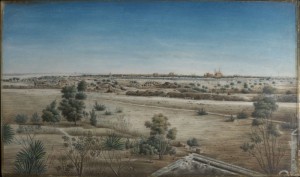
Mazhar Ali Khan (active 1840–55) A miniature panorama of Delhi with the fort in the distance ca. 1845 Watercolor on ivory Approx. H. 2 3⁄8 × W. 3 1⁄8 in. (6 × 8 cm) The Victoria and Albert Museum, IS 0.3563
This unusual landscape view of Shahjahanabad from the Ridge to the north shows the city as it was in the mid-1840s, with desolate, unsettled scrubland stretching out from the city walls. To the left of the picture, near the bank of the river Yamuna, can be seen the ruins of the extramural Qudsia Bagh complex and the first buildings of the new European suburb, the Civil Lines, including the battlements of Dr. Ludlow’s residence, quickly dubbed Ludlow Castle after the famous fortification in the Welsh borders. The main landmarks of the city rise up above the city walls, to the right, the triple domes of the Jama Masjid, the towers of the Lahore Gate of the Red Fort with its salmon-pink curtain wall, and finally, the dome of James Skinner’s St. James Church, which had just been completed when this view was drawn. The artist may have been sitting on the roof terrace of William Fraser’s house, which still survives amid the buildings of the Hindu Rao hospital.
This monumental painted cityscape of Delhi, dated November 25, 1846, is perhaps the first nearly 360-degree panorama ever to be painted by an Indian artist, surpassing all earlier landscape paintings from Delhi in detail, scale, and content. The protruding frame of the Lahore Gate is identifiable as the panorama’s vantage point. As we move clockwise from left to right, Mazhar Ali Khan’s skillful use of orthogonal frames directs the viewer’s gaze to the buildings, while the labels in both Urdu and English assert the view’s main focus. The British Resident Thomas Metcalfe has been suggested as the probable patron. His palatial bungalow is labeled, “Cothy [residence] of Thomas Metcalfe,” shown to the north of the city walls. As the eye moves from the turrets of the Lahore Gate to the Red Fort and its interior, European additions in the Qila are prominently displayed, as are the salatin quarters, inhabited by the often impoverished relatives of the imperial family. The sequence of labeled buildings constitutes the single most detailed portrait of nineteenthcentury Delhi, and is the only surviving image of many parts of the city following the 1857 uprising. The elite quarter of the city between the Lahore Gate and the Jama Masjid were both tragically dynamited by the British in 1858.
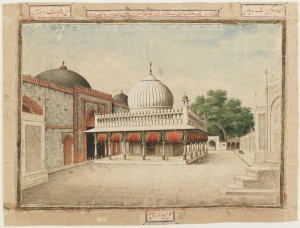
The dargah at Nizamuddin 19th century Opaque watercolor on paper H. 17 1⁄2 × W. 23 1⁄8 in. (44.5 × 58.8 cm) Arthur M. Sackler Gallery, Smithsonian Institution, Washington, D.C. Gift of S. Dillon and Mary Livingston Ripley, S1986.531
Nizamuddin, the greatest of all the Sufi shrines of Delhi, was founded over the tomb of the great fourteenthcentury mystic, Hazrat Nizamuddin Auliya. Nizamuddin came to Delhi from Afghanistan and preached a simple message of prayer and reconciliation. He promised his followers that if they loosened their ties with the world, they could purge their souls of worries and move towards direct experience of God. Rituals and fasting were for the pious, said this saint, but Love was everywhere, and was much the surest route to the Divine. Nizamuddin remains to this day the most popular shrine in Delhi frequented by pilgrims of all faiths.
James Skinner (1778-1841)
The Anglo-Indian mercenary James Skinner was, along with William Fraser and Thomas Metcalfe, one of the three greatest patrons of late Mughal painters outside of the Mughal court itself.
The son of Hercules Skinner, a Scottish soldier and the daughter of a Rajput landowner, Skinner initially took service with the Marathas, before being ejected from their ranks because of his British blood. Later he fought for the English, raising an Irregular Cavalry Corps, later known as Skinner’s Horse, made up of local cavalrymen with Sikh, Maratha, and Rohilla backgrounds, only to be increasingly discriminated against by the East India Company because of his Indian blood. His mixed inheritance was, he concluded, “like a two-edged blade made to cut both ways against me.” Although his chief wife was Muslim, Skinner himself was not. He did, however, live in an entirely Mughal style, and his English was stilted and ungrammatical.
Skinner was a landowner and Mughal courtier of great importance, helping to bridge the gap between the world of the Red Fort and that of the Company. He took a lively interest in the ordinary people, soldiers, and the landowners of the Delhi region, and employed the same group of artists to depict them as his friend William Fraser. Among these was the Mughal court painter Ghulam Ali Khan, who seems to have for some time been employed by Skinner at Hansi, a town in modern Haryana, one hundred kilometres west of Delhi.



